Elite life

Mushrooms
Russula
║ Mushrooms ║
Winecork Brittlegill (Russula adusta)
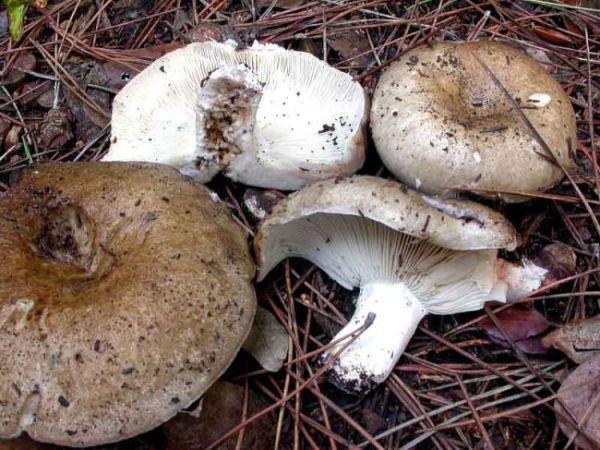
Winecork Brittlegill resembles Russula densifolia but the taste is mild and the flesh only becomes slightly pinkish in the first half-hour after exposure, sometimes remaining so in the cap, but in the stem becoming pale smoky grey and not dark grey or blackish. Cap 5-17 cm across, sticky when moist. Stem 40-110 x 10-30 mm. Smell of old wine casks. The oval spores (7-9 x 6-8 μm) have only very small warts, rarely exceeding 0.2-0.3 μm high, which are joined by very fine lines to form a well-developed but partial network with numerous small meshes. Cap hyphae narrow, 2-4 μm wide.
Russula albidula
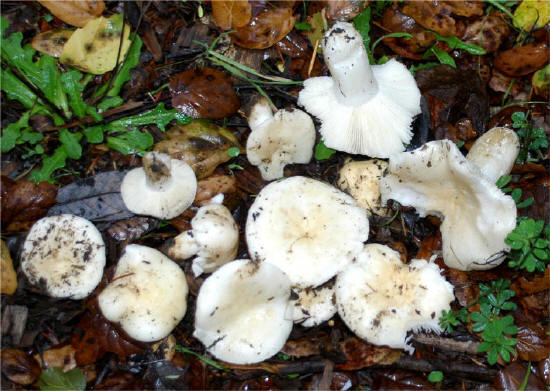
Cap: 2.5-5 cm; broadly convex to flat with a shallow depression; fairly slimy when wet, otherwise merely sticky; white; smooth; the margin not prominently lined, but occasionally faintly so; skin peeling away easily.
Gills: Attached or nearly free from the stem; crowded; not generally forking; white; not bruising.
Stem: 2.5-4 cm long; 0.5-1.5 cm thick; white; dry; often becoming cavernous in age; smooth.
Flesh: White; fragile.
Russula amoenolens

Cap: 4-10 cm across; convex, becoming broadly convex or flat, sometimes with a shallow central depression; sticky when fresh, but often dry when collected; light yellowish brown to dark yellowish brown; the margin lined and pimpled at maturity; the skin peeling away easily at the margin, sometimes beyond halfway to the center.
Gills: Attached to the stem; close, crowded, or nearly distant; whitish to yellowish or pale orangish; often discoloring yellowish brown to brownish.
Stem: 3-7 cm long and up to 2.5 cm thick; white, discoloring brownish to yellowish brown; more or less smooth.
Flesh: Whitish; unchanging.
Taste: Moderately to strongly acrid; odor waxy and reminiscent of maraschino cherries, almonds, or benzaldehyde.
Microscopic Features: 5.5-9 x 4.5-7 μm; broadly elliptical or, occasionally, nearly round; with spines up to 1 μm high, generally with few connecting lines, but sometimes with a few scattered connectors.
Russula cessans
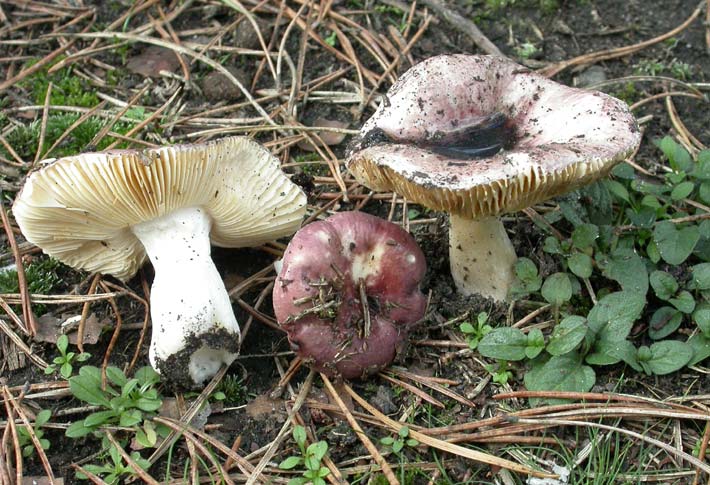
Cap 3-8 cm across, soon flattened; deep crimson to purplish red, often darker at the center; smooth, dry; peels halfway. Gills fairly close; pale ochre. Stem 30-50 x 10-20 mm, equal; white. Flesh white. Odor not distinctive. Taste mild. Spores broadly ovoid, 8-9 x 7-8 μm; warts 0.6-1 μm, high, many connectives forming a partial reticulum. Deposit deep ochre.
Firm Russula (Russula compacta)

Cap: 3-18 cm; convex when young, later flat or broadly convex, often with a slightly sunken center; sticky when fresh; more or less smooth, the cap "skin" sometimes breaking up in age; pale or almost whitish when young, but soon discoloring dirty yellowish to reddish brown, and in age appearing completely cinnamon; bruising reddish brown; the margin not lined.
Gills: Attached to the stem; crowded, close, or almost distant; white to cream, eventually yellowish cream; bruising and discoloring reddish brown.
Stem: 3-10 cm long; 1-3.5 cm thick; sturdy; more or less equal; dry; smooth; whitish, but soon flushed reddish brown; bruising reddish brown.
Flesh: White; discoloring yellowish to yellowish brown or reddish brown on exposure; thick.
Microscopic Features: Spores 7-10 x 6-8.5 μm; elliptical; ornamented with warts to 1 μm high; with a few amyloid ridges that rarely form a partial, broken reticulum.
Russula crustosa
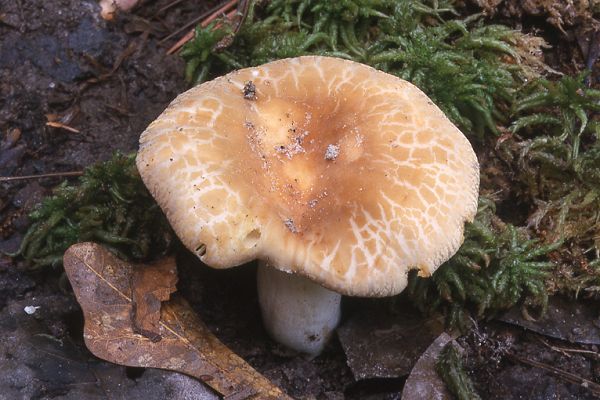
Cap: 5-10 cm; round to convex when young, becoming broadly convex to flat to uplifted with a shallow depression; dry; soon cracking up into patches; brownish, buff, yellowish brown or greenish, with lighter shades (including pale orange) mixed in; margin not lined to very slightly lined; cap "skin" peeling about half-way to the center.
Gills: Attached to the stem; close or crowded; some forking; white to cream.
Stem: 3.5-9 cm long; 1.5-3 cm thick; white; dry; smooth.
Flesh: White; brittle; thick.
Microscopic Features: Spores 6-9 x 5.5-7 μm; elliptical to nearly round; with warts to 0.5 μm high; without amyloid connecting lines.
Milk-White Russula (Russula delica)

Cap 5-16 cm across, convex, cup- or funnel-shaped, whitish, often tinged yellow brownish, matt, dry, thick-fleshed; margin strongly inrolled. Stem 20-60 x 20-40 mm, white, often bluish at apex, hard. Flesh white, unchanging. Taste hot and acrid with a bitter tang; smell distinctive, slightly of bugs and reminiscent of certain Lactarius, sometimes fishy. Gills decurrent, whitish, often tinged bluish towards the stem, often forked or with cross-connections, interspersed with numerous short gills. Spore print white, to slightly creamy. Spores ovoid with warts 0.5-1.5 μm high, often in chains or occasionally joined by fine lines not enclosing meshes, or sometimes more abundant and forming a network, 8-12 x 7-9 μm. Cap cystidia worm-like to narrow cylindrical.
Russula lutea
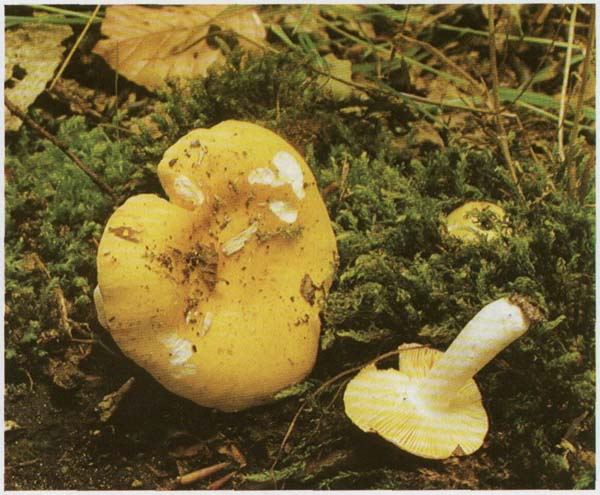
Cap 2-7 cm across, convex, later flattening or with a saucer-shaped depression, often entirely golden or egg-yolk yellow, but sometimes apricot, peach, flesh colored or coral in part or entirely, thin-fleshed, rather fragile, three-quarters to almost totally peeling. Stem 20-60 x 5-15 mm, white, cylindrical or club-shaped, soft, fragile. Flesh white. Taste mild, smell nil when young, later fruity and suggesting apricots. Gills deep saffron, strongly interlined. Spore print ochre. Spores ovoid-elliptic with warts up to 1 μm high, mostly isolated, very occasionally joined by a line, 7.5-9 x 6-8 μm. Cap cystidia absent; hyphae staining in fuchsin abundant, strongly encrusted, other hyphae often with club-shaped termination or with a round head (capitate).
Blackening Russula, Blackening Brittle Gill (Russula nigricans)
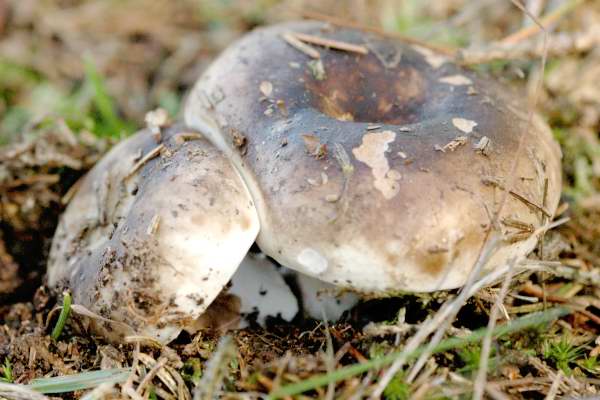
Cap: 5-15 (sometimes up to 20) cm; broadly convex when young, later flat with a central depression, or shallowly vase-shaped; slimy at first or when wet; more or less smooth; initially whitish but soon discoloring to brownish, ashy gray, or blackish; the margin not lined; without an easily discernible/separable "skin".
Gills: Attached or running very slightly down the stem; thick; distant, or nearly so; white to cream, eventually grayish, bruising blackish, usually with a reddish phase first.
Stem: 3-8 cm long; 1-4 cm thick; whitish at first, soon darkening like the cap; bruising reddish, then blackish over the course of as much as half an hour; smooth.
Flesh: White; hard; bruising promptly or slowly reddish on exposure, then blackish over the course of as much as half an hour or more.
Taste: Inconsistently recorded; mild or slowly slightly to very acrid. Odor inconsistently recorded; slightly fragrant, somewhat unpleasant, or not distinctive.
Microscopic Features: Spores 6-8 x 5-7 μm; with ornamentation under .5 μm high, connected by amyloid ridges forming a partial or complete reticulum; widely elliptical to nearly round.
Russula paludosa
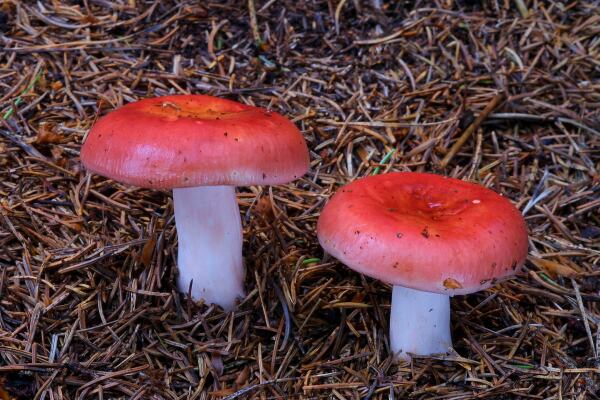
Cap 4-14 cm across, convex, later flattening and with a depression, red, blood-red, scarlet red, bay, apricot or ochre, sometimes with paler areas, fleshy, firm, slightly sticky when moist, half to three-quarters peeling. Stem 40-150 x 10-32 mm, white or tinged pink in part or entirely, cylindrical, narrow club-shaped or swollen in the middle. Flesh white. Taste mild. Gills adnexed, rather pale creamy golden yellow, connected by veins at their bases. Spore print deep cream. Spores ovoid or elliptic with warts up to 0.7-1.2 μm high, joined by lines to form a somewhat incomplete network, 8-10.5 x 7-8 μm. Cap cystidia sparse, cylindrical, without septa, with a few granules staining in fuchsin, moderately reacting to SV.
Russula rosea

Cap 4-9 cm across, convex, later flattening, red or pink, usually with cream centre or entirely so, moderately thick-fleshed, moderately firm, at most half peeling, dry, shiny or matt, sometimes powdered. Stem 40-70 x 10-20 mm, white, fairly fragile to somewhat firm, powdered at first, especially above; surface carmine with SV, especially when dry (distinguishes this species). Flesh white. Taste mild. Gills nearly free, pale cream, abundantly forked especially near stem. Spore print pale cream. Spores ovoid with warts up to 0.5 μm high, with few connecting lines, no network, 6-8 x 5-6.5 μm. Cap cystidia absent, narrow hyphae with incrustations staining in fuchsin present.
Russula variata

Cap: 5-15 cm; round to convex when young, becoming broadly convex to flat with a shallow depression; dry or slightly moist (never slimy); so variable in color that listing the colors hinders, rather than helps, the identification process--but often with olive, green, brown, rose, purple, white, and yellow shades (sometimes mottled, sometimes more or less uniformly one of these colors); the margin even and smooth, or very slightly lined in older specimens; skin peeling away easily at the margin, sometimes nearly half-way to the center.
Gills: Attached or slightly running down the stem; close or crowded; forking frequently and conspicuously, near the stem, near the cap margin, and in-between; white; occasionally spotting slightly brownish in age, but not bruising, and remaining white.
Stem: 3-10 cm long; 1-3 cm thick; white, occasionally discoloring brownish in places but not actually bruising; brittle; dry; often becoming cavernous (see illustration); smooth.
Flesh: White; brittle; thick.
Microscopic Features: Spores 7-11.5 x 5.5-9.5 μm; with warts 0.3-1 μm high; nearly elliptical or egg-shaped.
Bare-Toothed Russula, Russule Comestible (Russula vesca)

Cap 5-10 cm across, somewhat globose at first, later flattened convex, rather variable in colour, often with pastel tints, from dark or pale wine-coloured to buff, sometimes with olive or greenish tints, fleshy, firm, the skin half peeling, tending to retreat from the margin leaving the underlying flesh visible. Stem 30-100 x 15-25 mm, white, rather hard, often with somewhat pointed base. Flesh white. Taste mild, nutty. Gills adnexed, whitish to very pale cream, rather closely spaced, narrow, forked, especially near stem. Gills and stem surface rapidly deep salmon when rubbed with an iron salt. Spore print whitish (A). Spores ovoid with small warts up to 0.5 μm high, very occasionally with short lines attached or joining pairs, 6-8 x 5-6 μm. Cap cystidia cylindrical or spindle-shaped, without septa, hardly reacting to SV. Cap hyphae with cylindrical or tapering terminal cells or sometimes a long, tapering, thick-walled hair; supporting cells rectangular.
Russula violeipes
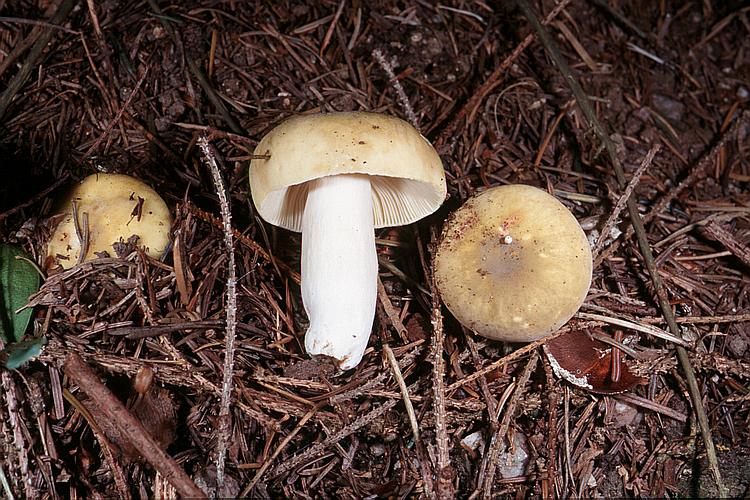
Cap 4-8 cm across, somewhat globose at first, then flattening and finally with a depression, straw, greenish-yellow (forma citrina) or olive tints, often in part, sometimes entirely, livid red, livid purple, lilac or wine-coloured, thick-fleshed, hard, powdered, hardly peeling. Stem 40-70 x 10-30 mm, white, often tinged yellow, violet, purple or wine-coloured, firm, often powdered especially above. Flesh white. Taste mild, smell slight, when fresh of shrimps. Gills slightly decurrent, pale buffy straw, greasy to the touch. Spore print cream. Spores ovoid with warts 0.7-1 μm high, joined by lines or ridges to form a fairly well-developed network, 6.5-9 x 6-8 μm . No cap cystidia and very few on the gills and not reacting to SV. Gill margin fringed with tapering cells. Terminal cells of cap hyphae mostly tapering, supporting cells mostly inflated, sometimes balloon-shaped.
Green-Cracking Russula (Russula virescens)

Cap: 5-15 cm; round to convex when young, becoming broadly convex to flat to uplifted with a shallow depression; dry; sometimes slightly velvety; soon cracking up into patches; green, with lighter shades mixed in; margin not lined to very slightly lined.
Gills: Attached to nearly free from the stem; close or crowded; white to cream.
Stem: 3-9 cm long; 2-4 cm thick; white; brittle; dry; smooth.
Flesh: White; brittle; thick.
Taste: Mild; odor not distinctive.
Microscopic Features: Spores 7-9 x 6-7 μm; with warts to 0.5 μm high; elliptical to nearly round; cystidia infrequent.
Shrimp Mushroom (Russula xerampelina)
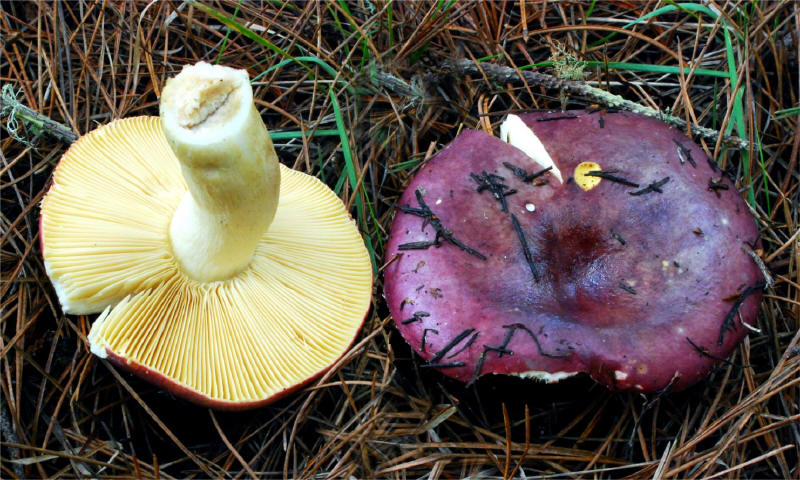
Cap 5-14 cm across, convex, later flattening and with a depression, colours very varied, often mixed, dull purples, reds, wine-coloured, cinnamon, straw, fawn, brick or dull brown, moderately firm, sometimes hard, soon dry and matt; margin eventually furrowed, one-quarter peeling at most. Stem 30-110x10-30 mm, white or tinted rose, staining honey to brownish ochre especially on bruising, firm to hard, reacting dull green when rubbed with iron salts. Flesh white. Taste mild, smell crab-like especially with age. Gills adnexed, pale to medium ochre, fairly broad and thick, connected by veins at their bases. Spore print deep cream to pale ochre. Spores ovoid with warts up to 1.2 μm high, lines none or few, occasionally enclosing a mesh, 8-11x6.5-9 μm. Cap cystidia infrequent, mostly narrow, not reacting to SV. Cap hyphae with terminal cells sometimes club-shaped, and these and the supporting cells inflated.
║ Mushrooms ║